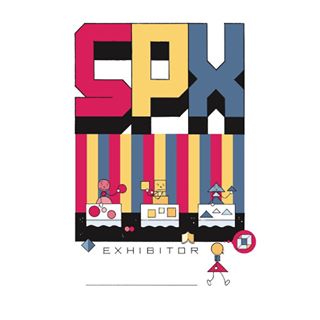
In Chris Ware’s exhibitor badge for the upcoming SPX convention,
three exhibitors sit behind their tables, hawking their comics and trying, perhaps
a little desperately (as their faces seem to suggest), to get the attention (and money)
of a passer-by. On the table in front of each artist is three of their self-produced comics.
It makes sense that each person makes comics whose geometric shape is exactly the shape that forms their creator's body. The exhibitors’ comics literally reflect and embody their author - they are personal, perhaps autobiographical art (explicitly or implicitly). At its best, SPX is not about generic corporate product, but about a personal vision: art as self-expression. In the badge’s scene, each exhibitor holds up an art manifestation of themselves for public approval or rejection. That takes some courage, especially to do it over and over for two days . . .
It makes sense that each person makes comics whose geometric shape is exactly the shape that forms their creator's body. The exhibitors’ comics literally reflect and embody their author - they are personal, perhaps autobiographical art (explicitly or implicitly). At its best, SPX is not about generic corporate product, but about a personal vision: art as self-expression. In the badge’s scene, each exhibitor holds up an art manifestation of themselves for public approval or rejection. That takes some courage, especially to do it over and over for two days . . .
Sadly, these exhibitors’ comics are sometimes treated by attendees as garbage; in the image, one of each shape-type is already strewn on the floor with other bits of trash (no wonder the artists look kind of sad). If you’ve ever been to SPX or a similar festival, you often see people’s freebies or promo material discarded, dropped in a garbage can or left on one of those long tables outside the ballroom. It’s sad, but it happens.
In Ware’s scenario, the person who walks by the artists has
no interest in this kind of personal work. In a thought balloon, the attendee imagines,
not the old-fashioned kind of two-dimensional art the exhibitors offer, but something
more exciting: she imagines a cube, which must be better than a flat square,
right? (The cube contains all the three exhibitors' colors and more.) It seems that the attendee passes
them because they want something figuratively – or perhaps literally
– three-dimensional, cube-like. The humble comic just doesn't cut it. (Maybe consumers are
conditioned to want something better, more expansive, like a video game, movie,
VR?) These days, how can a little stapled picture pamphlet hope to compete?
It might be tempting to say that Ware mocks the exhibitors;
but he, too, is a very personal – and highly geometrical – cartoonist. He most
often works in one of two modes, both of which are more geometrical than is typical of most
cartoonists. But one mode in particular – the mode of this illustration – is his 'hyper-geometrical' mode. Using this icon-based style, he's drawn many comics (often of the ‘sad joke’ type) about art, cartoonists, and himself (see below).
Though Ware's now one of America’s most celebrated cartoonists,
this wasn’t always the case. He did his time at cons where
no one paid any attention to alternative comics artists. Attendees quickly walked
by in search of the Marvel Comics display or something similarly lacking a singular artistic vision. So it’s easy for me to imagine that he sympathizes with these exhibitors’ plight.
I’d guess that many folks who have exhibited at small press shows can identify
with this scene, too.

